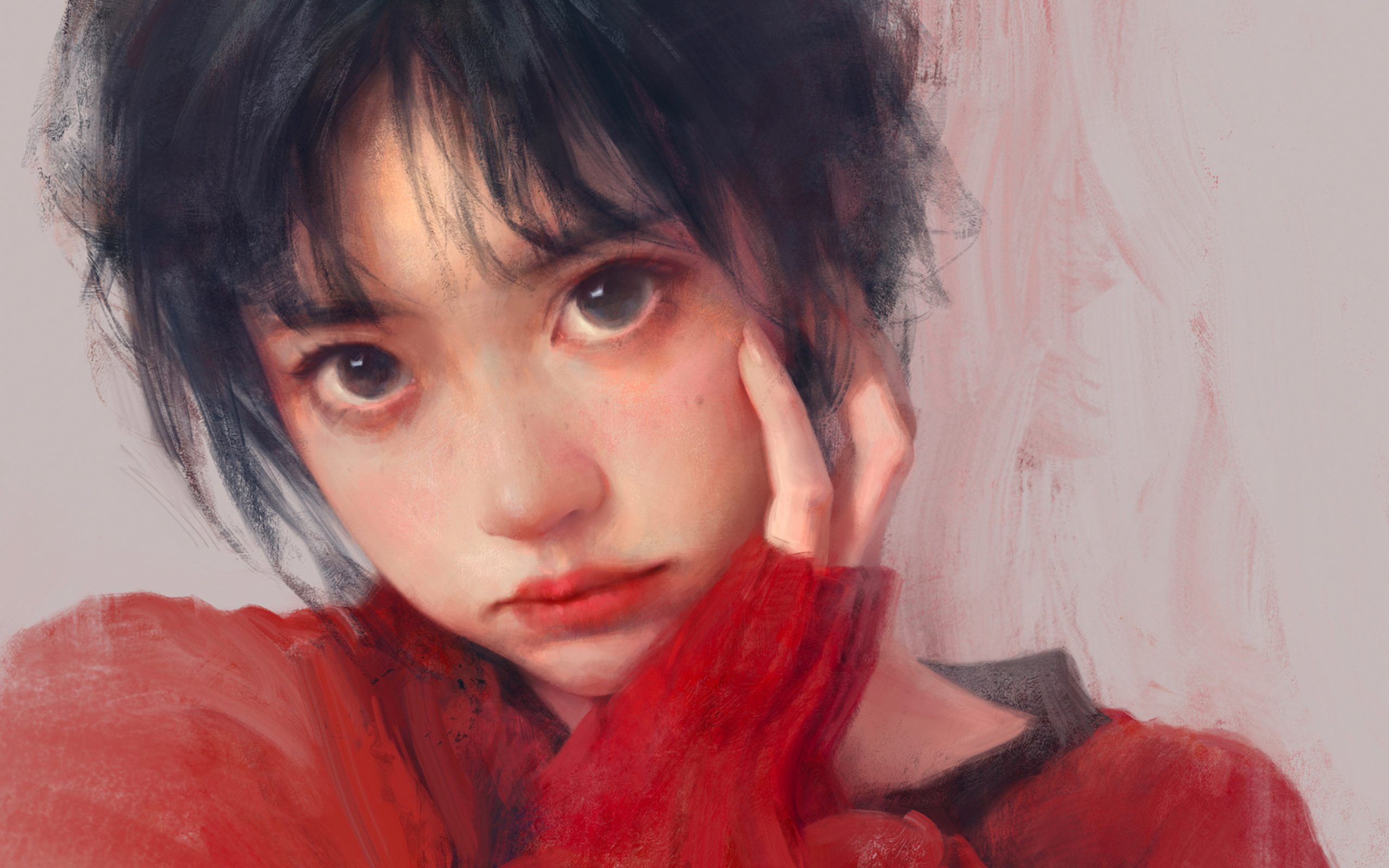Turbo Rails Tutorial-第四章
Turbo Drive
这一章我们将解释Turbo Drive是什么?它是怎么转化Link clicks和Form submissions为Ajax请求来加速Rails系统。
是什么?
Turbo Drive是Turbo的第一部分,已经被Rails7默认引入了,可以看一下Gemfile和application.js
# Gemfile
# Hotwire's SPA-like page accelerator [https://turbo.hotwired.dev]
gem "turbo-rails"// app/javascript/application.js
// Entry point for the build script in your package.json
import "@hotwired/turbo-rails"
import "./controllers"通过Turbo Drive,HTML页面不会被完全重新渲染,当我们的Turbo Drive拦截一个link clikc or a form submission时,这个Ajax请求的响应体只会替换HTML也页面中的
CSS和JS文件,后面就不需要再加载了。
但隐藏的问题是:如果服务端CSS和JS代码更新了,但用户之前访问过网页,CSS和JS不再更新怎么办?我们将在后面回答这个问题、
Turbo Drive是如何工作的?
Turbo Drive拦截了 links 的单击事件和 forms 的提交事件。
每次一个 link is clicked ,Turbo Drive 就会拦截该事件,重写默认的行为转为Ajax请求,并把结果中的
部分与原页面做替换。这也是为什么Rails7项目默认为单页面应用,页面第一次访问不会完全从新渲染,只有
部分。每当有links被click时,伪代码实现例如:
// Select all links on the page
const links = document.querySelectorAll("a");
// Add a "click" event listener on each link to intercept the click
// and override the default behavior
links.forEach((link) => {
link.addEventListener("click", (event) => {
// Override default behavior
event.preventDefault()
// Convert the click on the link into an AJAX request
// Replace the current page's <body> with the <body> of the response
// and leave the <head> unchanged
}
)});对于表单提交也是类似的,不再展示伪代码。
在前面我们讨论过,Rails7的一大变化。
Invalid form submissions have to return a 422 status code for Turbo Drive to replace the of the page and display the form errors.
422状态码就是指:Rails中的:unprocessable_entity,如果你看scaffold generator生成的代码,就会发现在#create and #update默认带有status: :unprocessable_entity。
Turbolinks是Turbo Drive的前身,只是前者只能拦截 clicks on links,不包含表单提交,现在Turbo Drive包含处理表单提交,所以作者重命名TurboLinks为Turbo Drive。
禁用Turbo Drive
在某些情况中,我们需要禁用Turbo Drive,比如某些Gem不支持Turbo Drive,一个好的应对方式就是在特定的地方禁用,例如登陆和退出的表单。下面我们示例禁用特定的links and forms
只需要添加:data-turbo="false"
比如在Quotes#index页面,让我们禁用新建功能中的Turbo Drive
<main class="container">
<div class="header">
<h1>Quotes</h1>
<%= link_to "New quote",
new_quote_path,
class: "btn btn--primary",
data: { turbo: false } %>
</div>
<%= render @quotes %>
</main>如果你去看控制台中的网络包,你会发现每次请求时有四个请求。
- One HTML request to load the Quotes#new HTML page
- One request to load the CSS bundle
- One request to load the JavaScript bundle
- One request to load the favicon of the page
这里是用谷歌浏览器,如果你是其他浏览器,可能不太一样
但如果我们恢复刚才的代码,再次请求,就会发现只有两个请求:
- One AJAX request to get the HTML for the Quotes#new page
- One request to load the favicon of the page
同样的我们也可以测试表单提交:
<%= simple_form_for quote,
html: {
class: "quote form",
data: { turbo: false }
} do |f| %>
<% if quote.errors.any? %>
<div class="error-message">
<%= quote.errors.full_messages.to_sentence.capitalize %>
</div>
<% end %>
<%= f.input :name, input_html: { autofocus: true } %>
<%= f.submit class: "btn btn--secondary" %>
<% end %>请求时,发现有五个请求包:
- One HTML request to submit the form
- The HTML redirection to the Quotes#index page
- One request to load the CSS bundle
- One request to load the JavaScript bundle
- One request to load the favicon of the page
当我们恢复时,再看只有三个请求包
- One AJAX request to submit the form
- The AJAX redirection to the Quotes#index page
- One request to load the favicon of the page
我们已经证明了Turbo Drive为我们做什么了。
- 它转化了所有的 Link clicks 和 form submissions 为AJAX请求,并加速应用
- 它阻拦了加载CSS和JS文件的重复加载
我们发现,我们也没有写一句JS代码
如果你想全局禁用Turbo Drive,虽然我们不推荐,你可以以下操作:
// app/javascript/application.js
import { Turbo } from "@hotwired/turbo-rails"
Turbo.session.drive = falseReloading the page with data-turbo-track=”reload”
之前我们说过,ajax请求仅仅替换
中的内容,而没有,导致用户无法使用最新的JS和CSS文件。为了解决这个问题,每次新的请求,Turbo Drive比较DOM节点中的data-turbo-track="reload"和响应中的
如果你看一下application.html.erb,就会发现:
<%# app/views/layouts/application.html.erb %>
<%= stylesheet_link_tag "application", "data-turbo-track": "reload" %>
<%= javascript_include_tag "application", "data-turbo-track": "reload", defer: true %>现在我们知道他的作用了。
这里你可以打开控制台去看一下请求,然后修改你的CSS或JS文件,再发一个请求,看一下和之前有什么区别?
注意:做一些小的测试体验,像上面那样,会让我们更清晰的明白发生了什么事儿,在下面的章节中我们还会做一些小的测试。
Changing the style of the Turbo Drive progress bar
随着Turbo Drive重写浏览器的默认行为,浏览器的进度条会受到一些影响。
Turbo已经为浏览器默认加载条构建了替代品,并且我们可以引入自己的样式,让我们先来写样式:
// app/assets/stylesheets/components/_turbo_progress_bar.scss
.turbo-progress-bar {
background: linear-gradient(to right, var(--color-primary), var(--color-primary-rotate));
}别忘了引入Sass文件
// app/assets/stylesheets/application.sass.scss
// All the previous code
@import "components/turbo_progress_bar";想要查看到我们的样式是否成功的加载,一个好办法就是让我们程序休眠几秒,我们可以试试:
# app/controllers/application_controller.rb
class ApplicationController < ActionController::Base
# Add this line to see the progress bar long enough
# and remove it when it has the expected styles
before_action -> { sleep 3 }
end现在你就能更方便的看到效果了,让我们删除这段用于休眠的临时代码吧。
结论
可以看到这一章很简单,我们基本没写什么自定义JS代码,就能获得实质性的性能提升。
下一章,我们将使用Turbo Freames去转化一些复合页面为小的片段页面。
Turbo Frames and Turbo Stream templates
这一章节,我们将学习如何切割页面为小的独立部分,读完这一章节后,增删改查行为就会统一在index页面展示。
要干嘛?
在我们现在的quotes编辑器中,当进行#new and #edit时,会跳转到其他的页面,而本章希望通过Turbo Frames and Turbo Streams做到当操作时,均在Quotes#index页面进行。可以看看线上的效果:https://www.hotrails.dev/quotes
在我们练习Turbo Frame技巧前,先画一些草图来说明我们要干的事儿,然后更新我们的系统测试。
现在我们的Quotes#index页面长这个样子
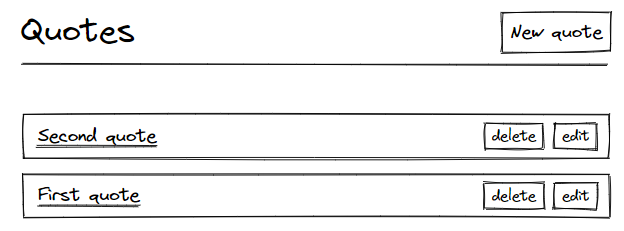
现在我们希望当点击New quote时,表单可以添加到原来页面的标题下面
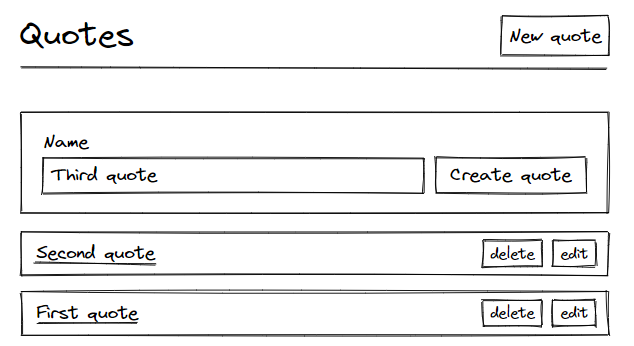
当我们点击Create quote按钮时,创建好的quote应该展示在quotes列表的最上面
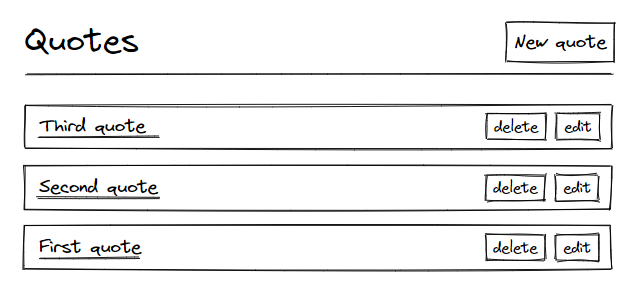
当我们点击第二个quote的Edit按钮时,表格应该直接替换选择的这个quote卡片
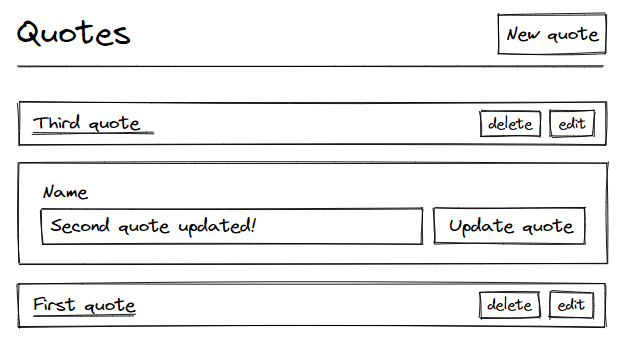
当我们点击Update quote按钮时,又展示回卡片的样式,并且数据更新

而其他的行为,应该不受到影响
- 点击
Delete按钮时,该条quote应该就被删除掉来了 - 点击quote的标题时,应该跳转到
Quotes#show页面
让我们现在更新测试代码来匹配对应的设想行为
# test/system/quotes_test.rb
require "application_system_test_case"
class QuotesTest < ApplicationSystemTestCase
setup do
@quote = quotes(:first)
end
test "Showing a quote" do
visit quotes_path
click_link @quote.name
assert_selector "h1", text: @quote.name
end
test "Creating a new quote" do
visit quotes_path
assert_selector "h1", text: "Quotes"
click_on "New quote"
fill_in "Name", with: "Capybara quote"
assert_selector "h1", text: "Quotes"
click_on "Create quote"
assert_selector "h1", text: "Quotes"
assert_text "Capybara quote"
end
test "Updating a quote" do
visit quotes_path
assert_selector "h1", text: "Quotes"
click_on "Edit", match: :first
fill_in "Name", with: "Updated quote"
assert_selector "h1", text: "Quotes"
click_on "Update quote"
assert_selector "h1", text: "Quotes"
assert_text "Updated quote"
end
test "Destroying a quote" do
visit quotes_path
assert_text @quote.name
click_on "Delete", match: :first
assert_no_text @quote.name
end
end什么是Turbo Frames?
Turbo Frames are independent pieces of a web page that can be appended, prepended, replaced, or removed without a complete page refresh and writing a single line of JavaScript!也就是可以添加,删除,替换独立的网页片段,而不需要刷新和写自定义的JS。
这一部分中,我们将使用几个小的案例来学习Turbo Frames,然后再实现我们上面的预想。
让我们创建第一个Turbo Frame,这里我们使用turbo_frame_tag helper,我们把Quotes#index页面中header部分嵌套到 id 为”first_turbo_frame”的Turbo Frame中
<%# app/views/quotes/index.html.erb %>
<main class="container">
<%= turbo_frame_tag "first_turbo_frame" do %>
<div class="header">
<h1>Quotes</h1>
<%= link_to "New quote", new_quote_path, class: "btn btn--primary" %>
</div>
<% end %>
<%= render @quotes %>
</main>如果你看一下DOM,Turbo Frame生成的HTML就长下面的样子
<turbo-frame id="first_turbo_frame">
<div class="header">
<h1>Quotes</h1>
<a class="btn btn--primary" href="/quotes/new">New quote</a>
</div>
</turbo-frame>如我们看到的,turbo_frame_tag helper帮助我们创建了
Turbo JavaScript Library中定义的元素。它拦截 form submissions and clicks on links,让这些frames成为你网页的独立部分!
现在点击New quote按钮,页面上被turbo-frame嵌套的部分消失了,并且浏览器控制台显示:Response has no matching <turbo-frame id="first_turbo_frame"> element,让我们来解释这奇怪的现象。
Turbo Frames cheat sheet
这一部分我们将探索一些应用于Turbo Frames的规则
尽管我们的例子都是 Links , 不过同样适用于 Forms
规则1:当你点击一个嵌套Turbo Frame的超链接,Turbo期待在目标页面中有一个相同ID的frame,然后目标页面的 frame内容将会替换原页面中的frame内容。
单纯去说,会比较难懂,我们来画一些草图,来更好的理解
现在的Quotes#index页面长这个样子:
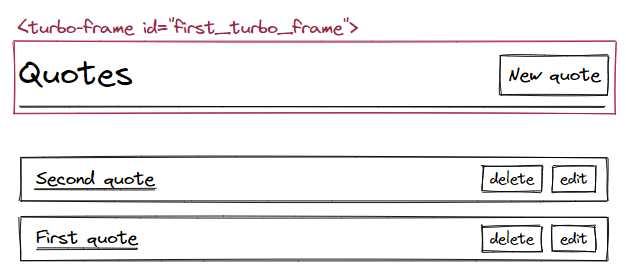
现在我们用同样的ID嵌套Quotes#new页面片段
为了匹配草图的内容,我们现在改改代码
<%# app/views/quotes/new.html.erb %>
<main class="container">
<%= link_to sanitize("← Back to quotes"), quotes_path %>
<div class="header">
<h1>New quote</h1>
</div>
<%= turbo_frame_tag "first_turbo_frame" do %>
<%= render "form", quote: @quote %>
<% end %>
</main>现在我们在浏览器中试试,当我们刷新Quotes#index页面,并且点击New quote按钮时,你会发现Quotes#new页面中被嵌套的内容,替换了Quotes#index页面中相同id的内容。
规则2:当你点击一个嵌套了Turbo Frame的超链接,但目标页面没有相同ID的frame,原先页面中嵌套的frame消失,并且以日志的形式响应异常信息,显示在控制台中。
还记得我们上面遇到的奇怪现象吗?这就是因为规则二导致的,如果你在Quotes#new的form上,再写其他ID的frame,刷新页面,并点击New quote,就会看到异常日志再次出现。
规则3:link 可以指定另外一个frame id去串联内容
这个规则很有用,但需要更多的草图去理解它,我们现在使用id为second_frame的Turbo Frame去嵌套quote列表,在Quotes#index页面
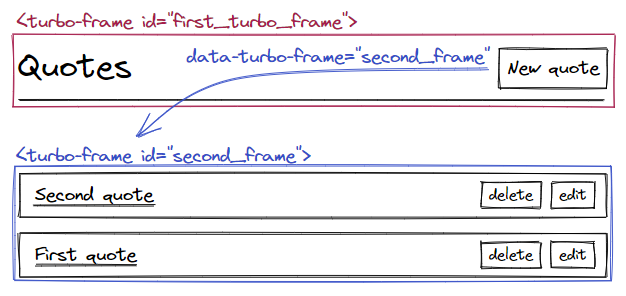
在Quotes#new页面中,让我们使用相同的ID去嵌套表单

根据草图,修改我们的源码,我在代码中标记了关键部分
<%# app/views/quotes/index.html.erb %>
<main class="container">
<%= turbo_frame_tag "first_turbo_frame" do %>
<div class="header">
<h1>Quotes</h1>
<%= link_to "New quote",
new_quote_path,
<% # 这里是关键,虽然被first_turbo_frame的frame嵌套 %>
但是指定了second_frame的frame %>
<% # 这里声明,将目标页面中,被id为second_frame嵌套的frame替换,当前页面中相同id的frame部分></%>
data: { turbo_frame: "second_frame" },
class: "btn btn--primary" %>
</div>
<% end %>
<%= turbo_frame_tag "second_frame" do %>
<%= render @quotes %>
<% end %>
</main>
<%# app/views/quotes/new.html.erb %>
<main class="container">
<%= link_to sanitize("← Back to quotes"), quotes_path %>
<div class="header">
<h1>New quote</h1>
</div>
<%= turbo_frame_tag "second_frame" do %>
<%= render "form", quote: @quote %>
<% end %>
</main>现在我们再试试,我们访问Quotes#index页面,刷新,点击New quoto按钮,可以看到我们的quotes列表被表单替换掉了。这个就是我们传递的 data: { turbo_frame: "second_frame" }发挥的作用。
注意:
有一个特殊的frame代表整个页面,但它并不是一个真是的Turbo Frame,但是又很像,所以你基本可以认为是一致的。
比如:如果你想让New quote按钮去替换整个页面,我们可以使用data-turbo-frame="_top"像下面这样:
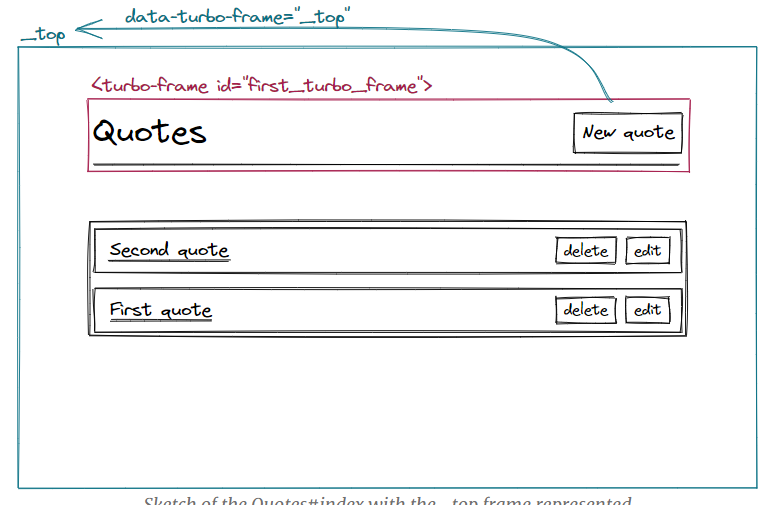
当然每个页面都默认有_top frame,所以Quotes#new也有
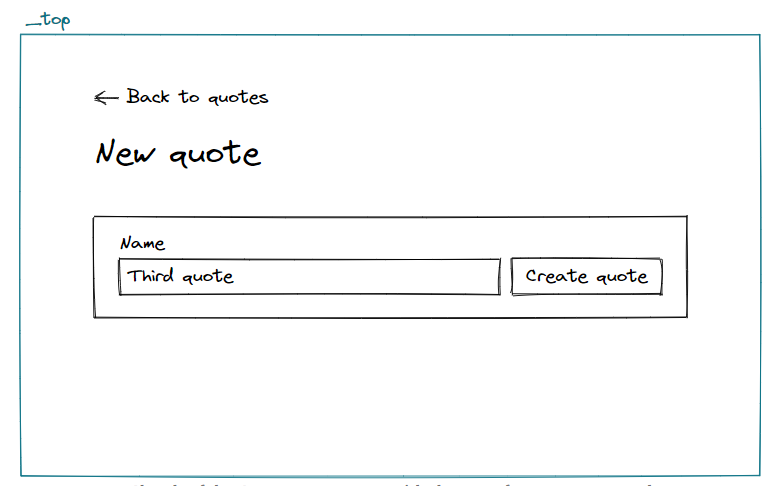
我们该代码试试:
<%# app/views/quotes/index.html.erb %>
<main class="container">
<%= turbo_frame_tag "first_turbo_frame" do %>
<div class="header">
<h1>Quotes</h1>
<%= link_to "New quote",
new_quote_path,
data: { turbo_frame: "_top" },
class: "btn btn--primary" %>
</div>
<% end %>
<%= render @quotes %>
</main>我们可以在Quotes#new页面中添加任意内容,因为浏览器会替换整个页面,例如:我们把Quotes#new页面恢复为最初的样子
<%# app/views/quotes/new.html.erb %>
<main class="container">
<%= link_to sanitize("← Back to quotes"), quotes_path %>
<div class="header">
<h1>New quote</h1>
</div>
<%= render "form", quote: @quote %>
</main>现在我们再访问Quotes#indexd页面,并进行添加,可以看到整个页面都被Quotes#new页面替换了,但是url没有变。
当使用**_top**关键词时,页面的URL会改变为目标页面的URL,这与使用常规Turbo Frame时的不同之处。
可以看到,Turbo Frames算是Rails开发人员的新增利器,它可以帮助我们切割独立的页面而不需要写什么JS代码。
上面的内容针对我们的项目基本够用了,但我们仍要学习两个东西:
- 怎么将
Turbo Frames与Turbo_stream fomat结合使用? - 如何对Frames命名,通过良好的约定
让我们开始练习,并通过测试,在此之前记得把Quotes#index页面恢复为最初状态
<%# app/views/quotes/index.html.erb %>
<main class="container">
<div class="header">
<h1>Quotes</h1>
<%= link_to "New quote", new_quote_path, class: "btn btn--primary" %>
</div>
<%= render @quotes %>
</main>Editing quotes with Turbo Frames
现在我们先做quotes修改部分使用Turbo Frames,目标就是当点击修改时,edit表单将会替换选中的quote数据。通过上面的学习,这一点很容易做到,但如何给这个Frame起一个好名字呢?
在Quotes#index页面中,每个被Turbo Frame嵌套的quote数据都应该有一个唯一ID,一个好的约定就是:模型单数形式_模型的ID,看我们画一个草图展示:

假如我们想编辑第二个数据,当我们点击edit时,我们需要Quotes#edit页面被同样的ID frame嵌套

通过合适的命名,当我们点击Quotes#index页面的edit按钮时,嵌套表单的frame将会替换嵌套第二条数据的frame。

现在开始代码实现,首先在Quotes#index页面,使用quote_#{quote_id}的frame嵌套住每条数据,而index页面的数据都来源于_quote.html.erb部分,所以我们只需要操作这部分:
<%# app/views/quotes/_quote.html.erb %>
<%= turbo_frame_tag "quote_#{quote.id}" do %>
<div class="quote">
<%= link_to quote.name, quote_path(quote) %>
<div class="quote__actions">
<%= button_to "Delete",
quote_path(quote),
method: :delete,
class: "btn btn--light" %>
<%= link_to "Edit",
edit_quote_path(quote),
class: "btn btn--light" %>
</div>
</div>
<% end %>下来是Quotes#edit页面
<%# app/views/quotes/edit.html.erb %>
<main class="container">
<%= link_to sanitize("← Back to quote"), quote_path(@quote) %>
<div class="header">
<h1>Edit quote</h1>
</div>
<%= turbo_frame_tag "quote_#{@quote.id}" do %>
<%= render "form", quote: @quote %>
<% end %>
</main>通过简单的几行代码,我们就实现了功能,你可以在浏览器中去查看,测试一下提交正常数据,异常数据是否都能正常工作。
不过你可能已经注意到当我们想查看quote详情时,不再起作用,并且当删除时,控制台中会爆出异常。这和上面的规则2有关,我们很快去解决,不过在此之前,我们聊聊dom_id helper帮助我们写出就简洁的Turbo Frame ids。
Turbo Frames and the dom_id helper
你可以传递一个字符串或者对象,它能帮助我们转为一个dom_id,比如:
# If the quote is persisted and its id is 1:
dom_id(@quote) # => "quote_1"
# If the quote is a new record:
dom_id(Quote.new) # => "new_quote"
# Note that the dom_id can also take an optional prefix argument
# We will use this later in the tutorial
dom_id(Quote.new, "prefix") # "prefix_new_quote"turbo_frame_tag helper 自动将对象,转为dom_id,所以我们可以改改之前在Quotes#index和Quotes#edit页面,传递对象即可,下面的代码是等价的:
<%= turbo_frame_tag "quote_#{@quote.id}" do %>
...
<% end %>
<%= turbo_frame_tag dom_id(@quote) do %>
...
<% end %>
<%= turbo_frame_tag @quote %>
...
<% end %>所以我们利用语法糖来改改:
<%# app/views/quotes/_quote.html.erb %>
<%= turbo_frame_tag quote do %>
<div class="quote">
<%= link_to quote.name, quote_path(quote) %>
<div class="quote__actions">
<%= button_to "Delete",
quote_path(quote),
method: :delete,
class: "btn btn--light" %>
<%= link_to "Edit",
edit_quote_path(quote),
class: "btn btn--light" %>
</div>
</div>
<% end %>
<%# app/views/quotes/edit.html.erb %>
<main class="container">
<%= link_to sanitize("← Back to quote"), quote_path(@quote) %>
<div class="header">
<h1>Edit quote</h1>
</div>
<%= turbo_frame_tag @quote do %>
<%= render "form", quote: @quote %>
<% end %>
</main>一切工作正常,我们继续。
Showing and deleting quotes
还是上面的问题:
- 查看quote详情没法正常工作了,数据也消失了,控制台也报错
- 删除按钮也在控制台报错了
现在的Quotes#index页面长下面的样子:
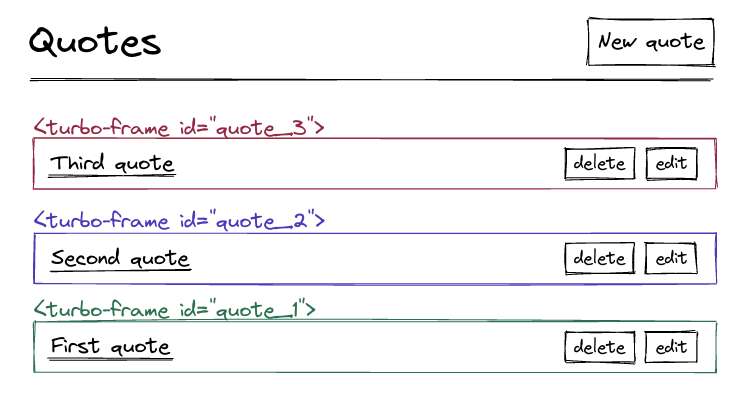
每个数据都被quote_id嵌套,但Quotes#show页面并没有相同的ID
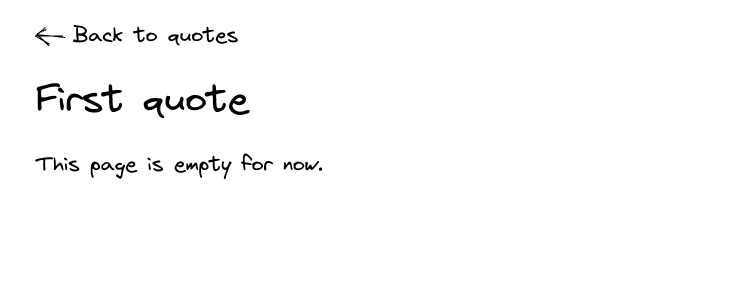
这里我们就使用"_top"来替换整个页面
<%# app/views/quotes/_quote.html.erb %>
<%= turbo_frame_tag quote do %>
<div class="quote">
<%= link_to quote.name,
quote_path(quote),
data: { turbo_frame: "_top" } %>
<div class="quote__actions">
<%= button_to "Delete",
quote_path(quote),
method: :delete,
class: "btn btn--light" %>
<%= link_to "Edit",
edit_quote_path(quote),
class: "btn btn--light" %>
</div>
</div>
<% end %>再在浏览器中测试,发现第一个问题就解决啦
我们也可以用同样的方式,解决第二个问题:
<%# app/views/quotes/_quote.html.erb %>
<%= turbo_frame_tag quote do %>
<div class="quote">
<%= link_to quote.name,
quote_path(quote),
data: { turbo_frame: "_top" } %>
<div class="quote__actions">
<%= button_to "Delete",
quote_path(quote),
method: :delete,
form: { data: { turbo_frame: "_top" } },
class: "btn btn--light" %>
<%= link_to "Edit",
edit_quote_path(quote),
class: "btn btn--light" %>
</div>
</div>
<% end %>一切工作良好,但出现了个副作用,比如当我们给第二个数据点击Edit时,这时还没有提交,然后删除下面的数据,则页面所有内容被替换,第二条数据的修改框也就没有了。
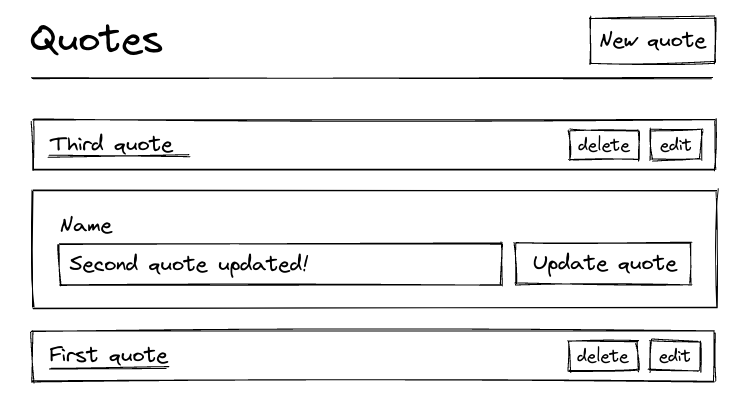
但我们希望的是删除第三条数据时,不影响其他的数据,Turbo and Rails再次帮助了我们,让我们先删除对Delete按钮做出的修改
<%# app/views/quotes/_quote.html.erb %>
<%= turbo_frame_tag quote do %>
<div class="quote">
<%= link_to quote.name,
quote_path(quote),
data: { turbo_frame: "_top" } %>
<div class="quote__actions">
<%= button_to "Delete",
quote_path(quote),
method: :delete,
class: "btn btn--light" %>
<%= link_to "Edit",
edit_quote_path(quote),
class: "btn btn--light" %>
</div>
</div>
<% end %>是时候介绍:Turbo_Stream format了
The Turbo Stream format
在Rails7中,表单提交会附带Turbo_Stream format,我们删除一个quote,并看看Rails的日志
Started DELETE "/quotes/908005781" for 127.0.0.1 at 2022-01-27 15:30:13 +0100
Processing by QuotesController#destroy as TURBO_STREAM可以看到#destroy带有Turbo_Stream,让我们看看怎么利用它去解决上面的问题
在Controller中,我们需要通过respond_to支持HTML和Turbo_Stream
# app/controllers/quotes_controller.rb
def destroy
@quote.destroy
respond_to do |format|
format.html { redirect_to quotes_path, notice: "Quote was successfully destroyed." }
format.turbo_stream
end
end我们创建对应的视图
<%# app/views/quotes/destroy.turbo_stream.erb %>
<%= turbo_stream.remove "quote_#{@quote.id}" %>我们在浏览器中再次删除quote,并查看响应的HTML数据:
<turbo-stream action="remove" target="quote_908005780">
</turbo-stream>这个就是turbo_stream helper接收了remove方法和"quote_#{@quote.id},然后又转化为了
当浏览器接收到了这段HTML代码,Turbo知道怎么拦截它,找到对应的参数ID,我们的例子中,就是删除掉已经被删除了的数据frame,而其他的页面不变,这正是我们想要的。
注意:当我写下本章内容时,turbo_stream helper可以帮助我们响应下面的方法:
# Remove a Turbo Frame
turbo_stream.remove
# Insert a Turbo Frame at the beginning/end of a list
turbo_stream.append
turbo_stream.prepend
# Insert a Turbo Frame before/after another Turbo Frame
turbo_stream.before
turbo_stream.after
# Replace or update the content of a Turbo Frame
turbo_stream.update
turbo_stream.replace当然除了需要一个对应的方法,turbo_stream helper也需要一个 partial and locals 作为参数,来知道需要操作哪个HTML使用对应方法。后面我们将展开学习。
有了Turbo Frame 和TURBO_STREAM format的结合,我们将能够在我们的网页上执行精确的操作,而不必写一行JavaScript,因此保留我们的网页的状态。
还有就是,turbo_stream helper 也可以使用dom_id,因此我们再修改:
<%# app/views/quotes/destroy.turbo_stream.erb %>
<%= turbo_stream.remove @quote %>Creating a new quote with Turbo Frames
也就是我们的quote编辑器新增功能,在深处实现之前,我们先画几个草图说明。
我们希望当点击New quote时,表单可以出现在页面头部的下面,当创建好后,把新加的数据放到列表的最上面,并删除原来的表单。为此我们需要多两个Turbo Frames:
- 一个空的Turbo Frame,帮助我们接收新增表单
- 一个Turbo Frame嵌套住原来的数据集合,然后可以让新的数据放到最前面。
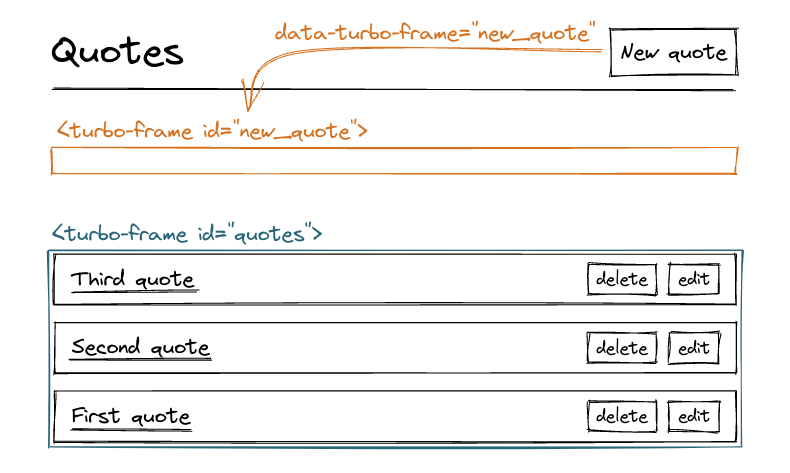

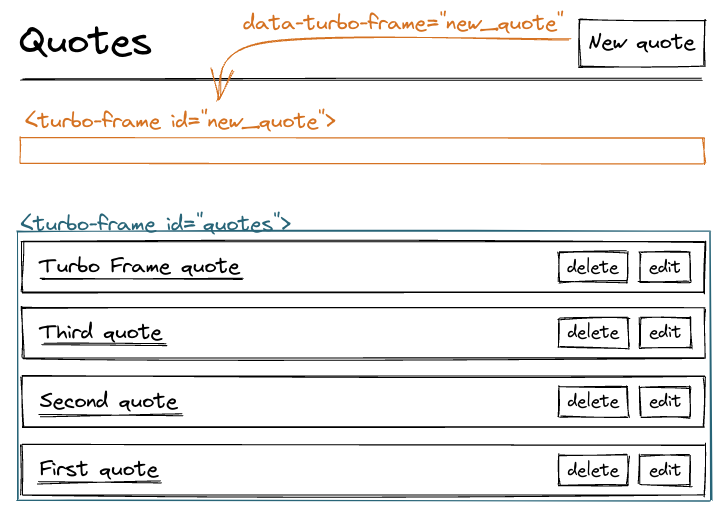
开始写代码:
Quotes#new页面
<%# app/views/quotes/new.html.erb %>
<main class="container">
<%= link_to sanitize("← Back to quotes"), quotes_path %>
<div class="header">
<h1>New quote</h1>
</div>
<%= turbo_frame_tag @quote do %>
<%= render "form", quote: @quote %>
<% end %>
</main>因为这里的@quote是一个新的记录,所以下面三个表达式是等价的:
turbo_frame_tag "new_quote"
turbo_frame_tag Quote.new
turbo_frame_tag @quote现在我们给Quotes#index页面中加入一个空Turbo Frame使用相同的ID,为了接收 new quote form。
<%# app/views/quotes/index.html.erb %>
<main class="container">
<div class="header">
<h1>Quotes</h1>
<%= link_to "New quote",
new_quote_path,
class: "btn btn--primary",
data: { turbo_frame: dom_id(Quote.new) } %>
</div>
<%= turbo_frame_tag Quote.new %>
<%= render @quotes %>
</main>可以看到我们添加了一个空的Turbo Frame,并且在”New quote”中指定:data: { turbo_frame: dom_id(Quote.new) }用来与连接这个空的Turbo Frame,也就是使用我们之前将的规则3。让我们写下会发生什么事儿:
- 当我们点击
New quote链接,点击事件会被Turbo拦截 - Turbo知道了该请求将会与id为
new_quote的frame进行互动,这源于我们在New quote链接上指定的data-turbo-frame - 该请求会以ajax形式发送,并且服务端会返回id为
new_quote的Quotes#new页面 - 当浏览器接收到了这段HTML,Turbo将会提取
Quotes#new页面中,id为new_quote的frame,然后替换Quotes#index中相同id的frame
我们再试试提交空的数据,当点击Create Quote按钮时,数据是异常的,而异常信息应该出现在页面中,我们再说的细一些
- 当我们点击
Create Quote按钮时,表单提交将被Turbo拦截 - 表单将被id为
new_quote的frame嵌套 - 服务端接收到了异常参数,并返回
Quotes#new页面并带有异常信息 - 浏览器接收到
status: :unprocessable_entity的响应时,就会将新的new_quote的frame替换原先的,并带有异常信息
现在我们已经完成了草图上的设计,还有一件事儿就是将正常添加的数据,放在数据列表的上面。
如果你在浏览器中去试试,发现虽然数据已经创建到数据库了,但数据并没有放到数据列表的最上面。这是为啥?
当我们用一个正常数据提交表单时,QuotesController#create将会返回Quotes#index页面,其中嵌套一个id为new_quote的空frame,Turbo将会用这个替换我们之前的表单,但是Turbo并不知道怎么处理这个新加的数据,它应该被放到哪里?所以我们将使用Turbo Stream view来处理。
先声明QuotesController需要同时支持HTML和Turbo_Stream formats:
# app/controllers/quotes_controller.rb
def create
@quote = Quote.new(quote_params)
if @quote.save
respond_to do |format|
format.html { redirect_to quotes_path, notice: "Quote was successfully created." }
format.turbo_stream
end
else
render :new, status: :unprocessable_entity
end
end然后再创建关联的视图
<%# app/views/quotes/create.turbo_stream.erb %>
<%= turbo_stream.prepend "quotes", partial: "quotes/quote", locals: { quote: @quote } %>
<%= turbo_stream.update Quote.new, "" %>在这个视图中,Turbo做了两件事儿
- 告诉Turbo去把
app/views/quotes/_quote.html.erb放到id为quotes的frame前面,这里可以看到我们可以直接传参关联。 - 第二行代码告诉Turbo去更新id为
new_quote的frame,变成空内容。
现在我们就修改Quotes#index页面,将quotes集合使用id为quotes的frame进行嵌套
<%# app/views/quotes/index.html.erb %>
<div class="container">
<div class="header">
<h1>Quotes</h1>
<%= link_to "New quote",
new_quote_path,
class: "btn btn--primary",
data: { turbo_frame: dom_id(Quote.new) } %>
</div>
<%= turbo_frame_tag Quote.new %>
<%= turbo_frame_tag "quotes" do %>
<%= render @quotes %>
<% end %>
</div>现在我们再在浏览器中看看,如果你打开控制台的网络,你将看到表单提交的响应内容将会长下面的样子:
<turbo-stream action="prepend" target="quotes">
<template>
<turbo-frame id="quote_123">
<!-- The HTML for the quote partial -->
<turbo-frame>
</template>
</turbo-stream>
<turbo-stream action="update" target="new_quote">
<template>
<!-- An empty template! -->
</template>
</turbo-stream>我们传递的参数,可以被Turbo理解,然后Turbo执行对应的行为(append, prepend, replace, remove)在目标Fream中
现在我们讲讲一些技巧,关于Turbo Stream views中,不同的写法代表的意思是一样的。
- 这是我们之前写的
<%# app/views/quotes/create.turbo_stream.erb %>
<%= turbo_stream.prepend "quotes", partial: "quotes/quote", locals: { quote: @quote } %>
<%= turbo_stream.update Quote.new, "" %>- 当一行过长时,我们可以修改一下
<%# app/views/quotes/create.turbo_stream.erb %>
<%= turbo_stream.prepend "quotes" do %>
<%= render partial: "quotes/quote", locals: { quote: @quote } %>
<% end %>
<%= turbo_stream.update Quote.new, "" %>- 而在Rails中下面的表述是一致的
render partial: "quotes/quote", locals: { quote: @quote }
render @quote- 所以我们将我们写的进行简化
<%# app/views/quotes/create.turbo_stream.erb %>
<%= turbo_stream.prepend "quotes" do %>
<%= render @quote %>
<% end %>
<%= turbo_stream.update Quote.new, "" %>- 而这里的行并不长,所以不需要使用块儿语法
<%# app/views/quotes/create.turbo_stream.erb %>
<%= turbo_stream.prepend "quotes", @quote %>
<%= turbo_stream.update Quote.new, "" %>够优雅吧?这就是一些写Turbo Stream views的不同方式
Ordering our quotes
还有一个细节问题,当我们觉得把新加的quote加入到quotes列表的最前面时,但页面刷新时,顺序又乱了,我们应该保证quotes始终按照时间进行倒序展示,最新的放在最上面,让我修改一下Quote model
# app/models/quote.rb
class Quote < ApplicationRecord
validates :name, presence: true
scope :ordered, -> { order(id: :desc) }
end然后再在Controller#index中使用
# app/controllers/quotes_controller.rb
def index
@quotes = Quote.ordered
end现在即使页面刷新,顺序也是不变的。
记得修改对应的测试代码,来让测试通过
# test/system/quotes_test.rb
setup do
# We need to order quote as well in the system tests
@quote = Quote.ordered.first
end测试已经可以全部通过了,我们学习了很多技巧,而几乎只写了几行代码
Adding a cancel button
现在一切工作良好,但是我们希望可以加一个Cancel按钮在quotes/_form.html.erb视图中。
<%# app/views/quotes/_form.html.erb %>
<%= simple_form_for quote, html: { class: "quote form" } do |f| %>
<% if quote.errors.any? %>
<div class="error-message">
<%= quote.errors.full_messages.to_sentence.capitalize %>
</div>
<% end %>
<%= f.input :name, input_html: { autofocus: true } %>
<%= link_to "Cancel", quotes_path, class: "btn btn--light" %>
<%= f.submit class: "btn btn--secondary" %>
<% end %>我们在浏览器中试试看,发现一切正常,我们看看到底发生了什么
当我们点击 new quote form 中的Cancel链接时
- 这里的link是嵌套在id为
new_quote的Frame中,所以Turbo也只会替换这部分内容 - 这里的link导航到了
Quotes#index页面,其中嵌套了id为new_quote但是是空的frame - Turbo就用目标页面的空frame替换掉了原来页面的form表单,所以表单消失了
当我们点击 edit quote form 中的Cancel链接时
- 这里的link是嵌套在id为
dom_id(quote)的frame中,所以也是替换这部分 - 这里的link导航到了
Quotes#index页面,其中嵌套了id为dom_id(quote)的frame,内部含有对应quote的html数据 - 然后引用这段html替换,原先的form表单,所以表单消失了
当我们再创建quote并且同时修改多个quote时,我没法发现页面的状态是保留的,这么的各个部分是独立保留的,这就是Turbo带给我们的能力,而不需要写自定义的JS。
Wrap up
这一章节,我们替换了原先传统的CRUD,变成一个响应式应用,而这几乎不需要什么代码,你可以试着创建,修改,删除,查看数据,感受一下我们的应用。学了很多东西,让我们休息一下,然后把所有内容理清楚。
下一章中,我们将使用Active Cable来给系统加入实时更新的特点。
